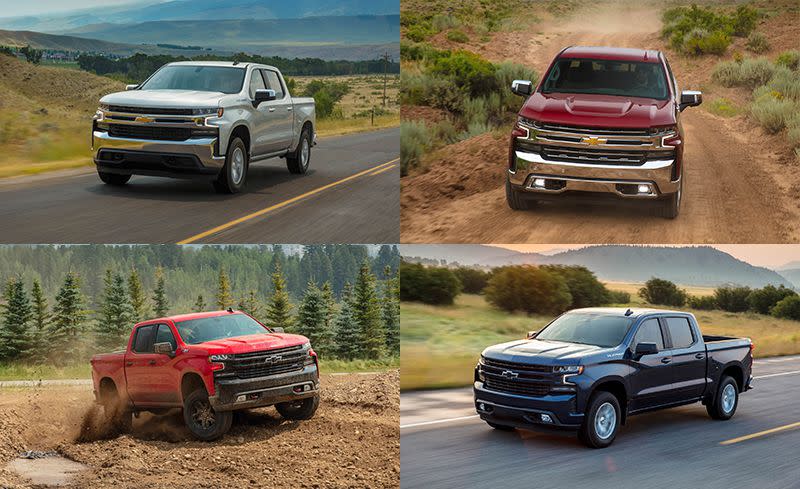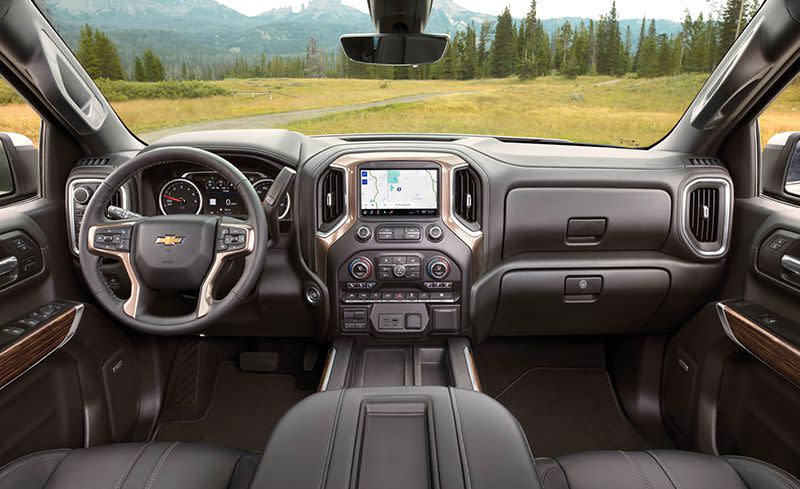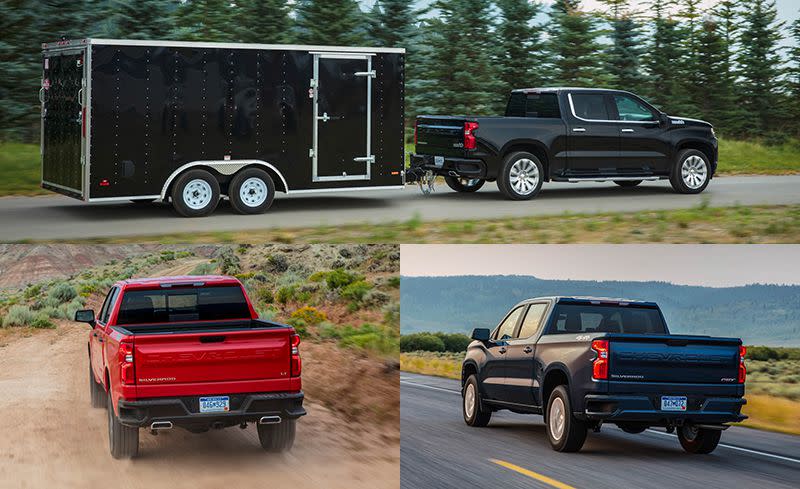2019 Chevrolet Silverado 1500 Driven: Longer, Lighter, More Fuel Efficient, and Extremely Refined

Don’t tell anyone at General Motors, but the eighth-generation Chevrolet Silverado doesn’t look, you know, radically different from the company’s seventh-generation pickup. Or the sixth-generation Silverado, for that matter. Yes, there’s a bold new grille design (four of them, actually), and the body panels have lost some of the outgoing model’s aggressive rectilinearity. And, yes, truck customers already like the way their trucks look. Based on on appearance alone, a person could be forgiven for thinking that the 2019 Silverado promises only small changes. But that person would be wrong. The truck wars are raging as hard as ever, and Chevrolet has invested heavily in the fight to keep up with its ever-improving competition.
The Silverado will launch with a familiar powertrain lineup, including a standard 285-hp 4.3-liter V-6 paired to a six-speed automatic transmission. Selectable transfer cases are available, and depending on the trim, some include an all-wheel-drive mode. A 355-hp 5.3-liter V-8 with an eight-speed automatic and a 420-hp 6.2-liter V-8 mated to a 10-speed automatic are step-up powertrain combos. The innovation takes the form of Chevy’s new Dynamic Fuel Management (DFM) system, available on both V-8s. Customers of Chevrolet’s trucks and SUVs will already be familiar with the company’s Active Fuel Management, which allows equipped V-8 engines to operate using just four cylinders when loads are light in order to save fuel. DFM takes the idea further, allowing either of the Silverado’s eight-pots to operate using as few as two cylinders, depending on the driver’s demand for torque. An all-new 310-hp turbocharged 2.7-liter inline-four and a still-mysterious 3.0-liter diesel inline-six will join the Silverado lineup after its launch this fall.
During a drive of a 5.3-liter Silverado equipped with DFM, we failed to notice any difference in driving characteristics or NVH as the engine shuffled among its 17 available firing orders, even with a calibration tool calling out the changes in real time. An engineer involved with the development of the system conceded that he could occasionally feel changes in the firing order, but, unlike with earlier AFM tuning, anyone who has successfully internalized the concepts behind The Princess and the Pea should be satisfied with the technology. General Motors claims it improves fuel economy by about 5 percent.
The truck feels surprisingly lithe on the road, building on its predecessor’s solid dynamic repertoire. There is none of the jouncing and bouncing once associated with driving an unladen pickup. And at long last, the Chevy’s steering column is finally squared to the driver, after years of being angled slightly to the left. Appropriately heavy for a vehicle this size, the wheel responds smoothly and accurately to inputs and feels even slightly heavier in the Silverado’s new Sport driving mode. We felt that the 5.3-liter Silverado’s eight-speed was often slow to downshift when climbing a hill at part throttle, but otherwise it faded into the background.
Even when driving on curvy mountain roads, it was easy to forget how large this truck is, both inside and outside. The five-foot-10-inch short bed is seven inches wider than the one on last year’s model, while the crew cab’s wheelbase is four inches longer, its overall length has increased by about 1.6 inches, and the truck is 1.2 inches wider. There are also 2.5 inches more rear-seat legroom than in the outgoing model, and a two-inch suspension lift is available from the factory. Massive quantities of interior storage space include the usual center-console cubbies as well as storage compartments below the rear-seat bottoms and hollowed out of the rear seatbacks.
If that’s still not enough, you can always tow the rest of your belongings behind you. Chevy is attempting to provide peace of mind for frequent and infrequent haulers alike by offering an optional tow package that uses cameras to show close-up views of the trailer hitch and the trailer itself. Those video feeds can be displayed on the infotainment screen for up to eight seconds while the vehicle is in motion. It works like a video baby monitor, apprising owners of the basic status of their precious cargo without the need to pull over to check on it themselves. The system also can store information about several trailers, allowing owners to track mileage on each one and set service reminders at appropriate intervals. There are also training videos that act as stand-ins for on-screen, real-time trailer backup guidance, which is a feature available in the latest Ford F-150 but not in the Silverado.
The 2019 Silverado will be available in eight trims, with crew-cab V-8 models hitting dealer lots first. Chevrolet has spent huge sums of money developing new technology and manufacturing procedures for this truck, and the effort shows. This truck is so drivable and useful that it could even be a logical step up from a mid-size crossover, something that Chevrolet’s bean counters must fervently desire given the handsome profit margins on full-size pickups. The real question is not whether this Silverado is good, which it is, but whether it has enough firepower to unseat the Ford F-150 and retain its edge over the also new, also good Ram 1500. Only the monthly sales figures-and additional drives of the all-new engines-will tell us for sure, but Chevrolet has given itself a very good shot.
('You Might Also Like',)




